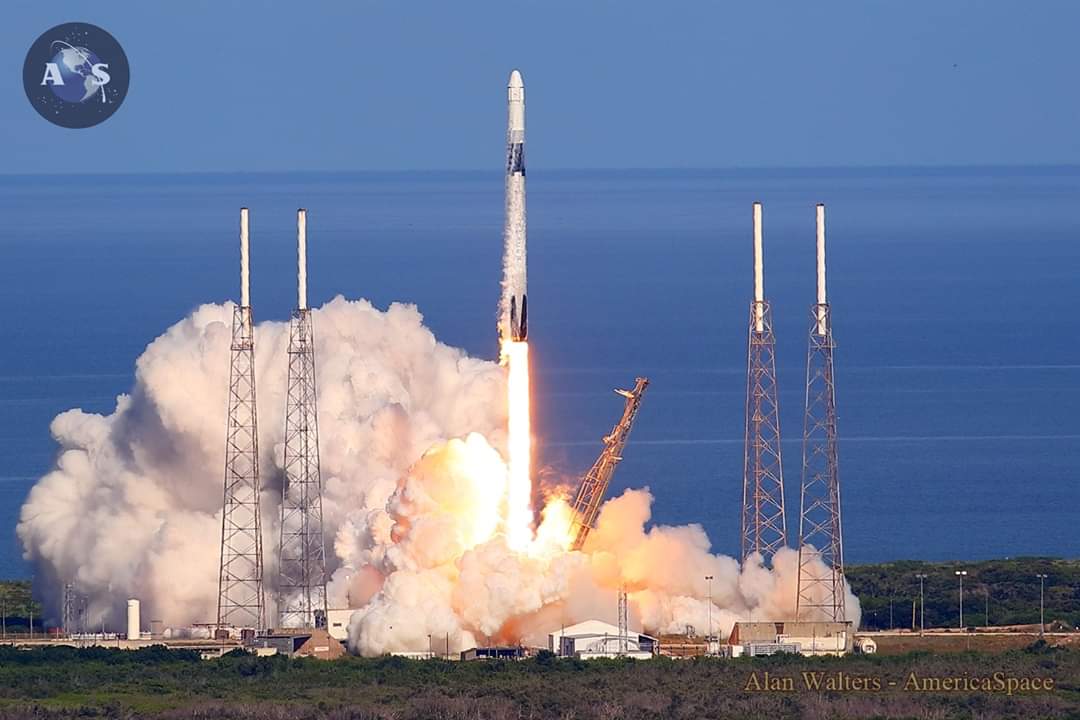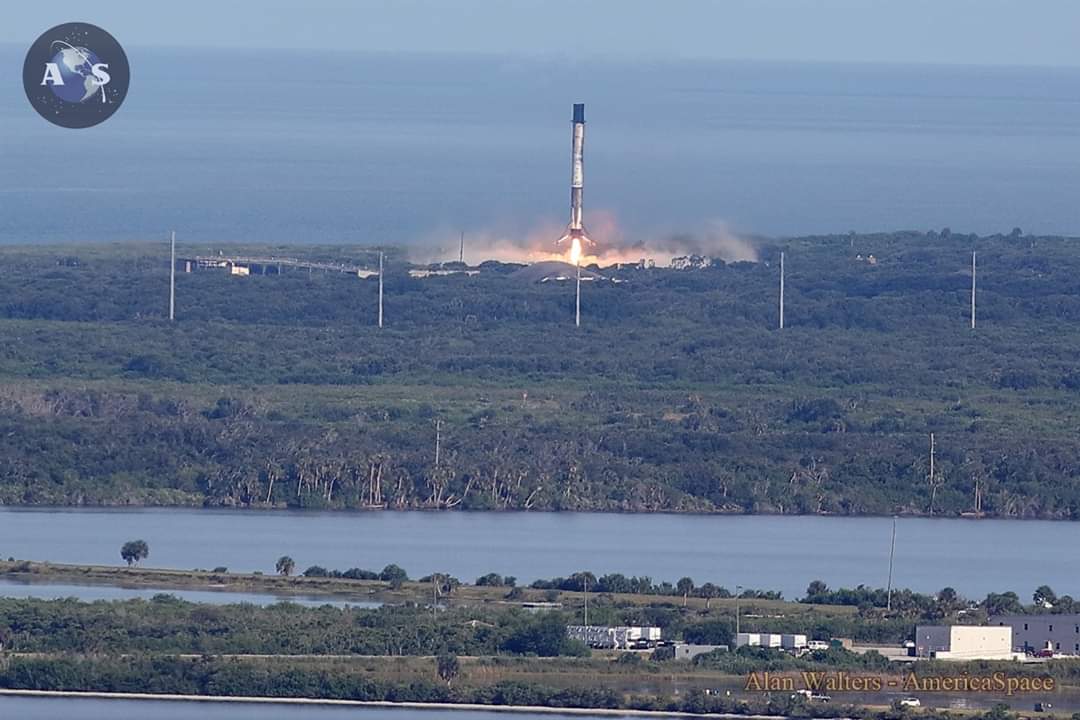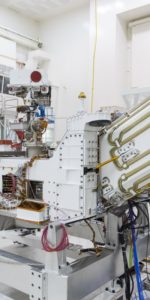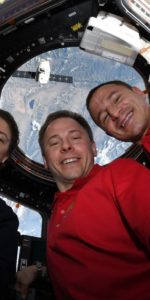
The International Space Station (ISS) is shaping up to be America’s go-to destination of choice this month, with the successful 20 July launch of Soyuz MS-13—carrying Russian cosmonaut Aleksandr Skvortsov, U.S. astronaut Drew Morgan and Italy’s first and only spacewalker, Luca Parmitano—and today’s flight of another SpaceX Dragon cargo mission, bound for the sprawling multi-national outpost. An Upgraded Falcon 9 booster lifted off smoothly from Space Launch Complex (SLC)-40 at Cape Canaveral Air Force Station, Fla., at 6:01 p.m. EDT Thursday, 25 July, bound for a Saturday morning arrival with equipment and provisions for the incumbent Expedition 60 crew.
As detailed in AmericaSpace’s CRS-18 preview article, the Dragon—flying a personal-best-beating third time—is carrying a new International Docking Adapter (IDA-3) for Commercial Crew operations and a wide range of experiments whose benefits can be felt on Earth and in space.
CRS-18 is the latest installment in SpaceX’s Commercial Resupply Services contractual arrangement with NASA, signed back in December 2008. This initially called for 12 Dragon flights to the ISS, ferrying up to 44,000 pounds (20,000 kg) of payloads and supplies, but three additional missions were secured in early 2015, followed by five more in early 2016. These missions—which will see the CRS1 first round close-out with the CRS-20 Dragon flight, currently targeted for March 2020—will bridge the gap before the second-round CRS2 contracts kick off in late summer of next year. Primary unpressurized payloads aboard CRS-19 include Japan’s Hyperspectral Imager Suite (HISUI) remote-sensing instrument and CRS-20 will deliver the European Space Agency’s (ESA) Bartolomeo commercial payloads anchor for installation onto the forward face of the Columbus lab. When the CRS2 contract begins next year, SpaceX expects to stage at least six more ISS-bound cargo flights with its enhanced Dragon vehicle, through 2024.
Tonight’s CRS-18 launch marks the 23rd time in a little over two years that Upgraded Falcon 9 first-stage hardware has been utilized on a second mission; this figure includes the maiden test-flight of the Falcon Heavy in February 2018 and its most recent outing, just last month, both of which featured recycled side boosters. The B1056 core stage for CRS-18 had previously seen service just 12 weeks ago to deliver the CRS-17 Dragon to the space station and, blackened and scorched from that ascent and smooth return back to Earth, it was today teamed with a sparkling-new second stage and the twice-flown CRS-18 Dragon at its tip. The 230-foot-tall (70-meter) vehicle was trundled out of the Horizontal Integration Facility (HIF) to SLC-40 on 15 July and completed a customary Static Fire Test of its nine Merlin 1D+ first-stage engines on 19 July. Conclusion of this significant task cleared the way for Wednesday evening’s opening launch attempt.
Weather conditions along the Space Coast were expected to be only 30-percent-favorable, remaining the same in the event of a 24-hour scrub to Thursday. “A weak tropical disturbance currently across the Bahamas will track northwest and bring an increasing threat of showers and thunderstorms to the Space Coast tomorrow,” noted the 45th Weather Squadron at Patrick Air Force Base in its L-2 briefing on Monday morning. “Even as this system eventually gets pulled north and northeast away from Florida mid-to-late week, a strong upper level trough moving across the Southeast U.S. will support an unsettled weather pattern locally. Steering flow aloft will be conducive to bring thunderstorms from interior Florida to the east coast Wednesday and Thursday afternoon and evening. Thus, the primary weather concerns for launch are cumulus clouds and their associated anvil clouds, as well as lightning. High pressure will attempt to build back across the area over the weekend which should support more favorable launch conditions.”
Notwithstanding the poor outlook, SpaceX pressed into fueling and proceeded through a smooth countdown, even as gloomy skies rolled overhead. But Wednesday was not to be. At T-30 seconds, the Launch Director called a hold in the countdown—although the Eastern Range had declared itself ready to support the launch, the intractable weather was still classified as “No-Go”—and the attempt was accordingly scrubbed.

With a backup opportunity targeted for 6:01 p.m. EDT Thursday, the rise of CRS-18 promised a spectacular early-evening show of light and noise for the gathered spectators at the Cape. Loading of liquid oxygen and a highly refined form of rocket-grade kerosene (known as “RP-1”) began 35 minutes before the targeted launch window, which opened and closed “instantaneously” at 6:24 p.m. EDT, due to phasing requirements associated with reaching the ISS. Passing T-10 minutes, the terminal autosequencer was initiated and the engines were chilled, preparatory for ignition. At T-2 minutes, the Air Force Range Safety Officer verified that all ground-side assets were “Go for Launch” and the Upgraded Falcon 9 transitioned to internal power and entered “Startup” at 60 seconds to go.
With three seconds remaining on the countdown clock, the nine Merlins roared to life, pumping out an estimated 1.5 million pounds (680,000 kg) of thrust, before departing SLC-40 on time and powering away into the steadily darkening Florida sky. The first stage burned for 2.5 minutes, before separating from the stack and beginning its multiple-burn descent back to alight on Landing Zone (LZ)-1 at the Cape, where it has been suggested B1056 may fly a third time to launch the next Dragon, CRS-19 in December. Touchdown of the blackened and scorched core stage occurred at 6:09 p.m. EDT, about 8.5 minutes after liftoff.
The single Merlin 1D+ Vacuum engine of the second stage now took over, pushing the CRS-18 Dragon into low-Earth orbit. During the course of its long burn, Dragon’s protective nose fairing was jettisoned to expose the berthing mechanism which it will use on Saturday morning to link up with the ISS.
Ten minutes after leaving the Cape, the cargo ship separated from the final stage of the booster and began to configure itself for a 36-hour transit to catch the orbital outpost. Its power-producing solar arrays were satisfactorily deployed and its Guidance and Navigation Control (GNC) Bay Door opened to expose critical rendezvous sensors. Early Saturday, Expedition 60 astronauts Nick Hague and Christina Koch—based in the station’s multi-windowed cupola, at the controls of the 57.7-foot-long (17.6-meter) Canadarm2—will grapple CRS-18 and robotics controllers at the Johnson Space Center (JSC) in Houston, Texas, will oversee its berthing at the Earth-facing (or “nadir”) port of the Harmony node. It will remain part of the station through at least 19-20 August.
.
.
FOLLOW AmericaSpace on Facebook and Twitter!
.
.





